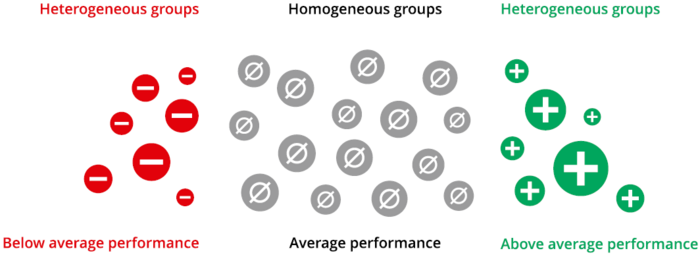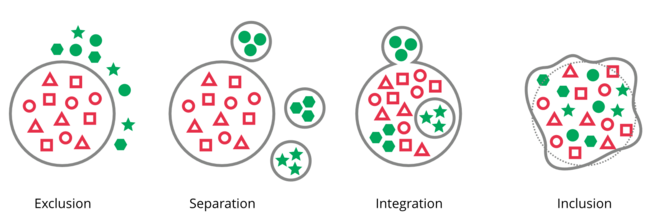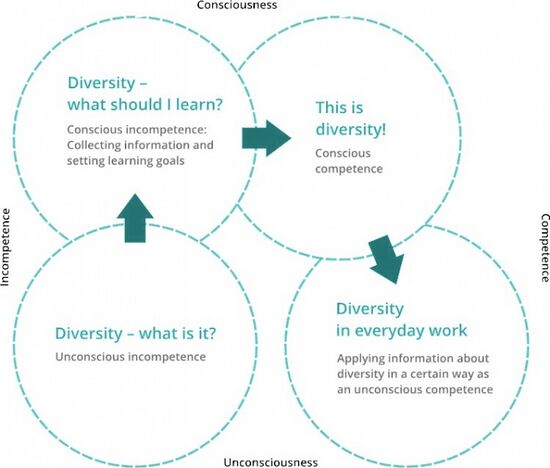Contents
- 1 Addressing Discrimination and Under-representation
- 2 Definition
- 2.1 Social diversity
- 2.2 Personality diversity
- 2.3 Informational diversity
- 2.4 Value diversity
- 2.5 Attention to Backgrounds, Discrimination and Privileges
- 2.6 Internal Dimensions
- 2.7 External Dimensions
- 2.8 Organizational Dimensions
- 2.9 EU Charter of Fundamental Rights
- 2.10 Direct Discrimination
- 2.11 Indirect Discrimination
- 2.12 Associated terms
- 3 Managing Diversity
- 4 Inclusivity
- 5 Challenge and Mission
- 6 Toward Diversity Competence
- 7 Inspiring Handbooks and Sources from the Community
- 8 References
Addressing Discrimination and Under-representation
Anyone who believes that a vibrant civil society depends on individuals’ involvement must take into account that this may only be legitimized and actualized if every individual has the same rights to articulate themselves and be involved and if there is equality in chances for articulation and involvement. In our daily life and work, we all face the scarcity of these conditions. In consequence, one important condition and mission for citizenship education is to work against structural discrimination and under-representation of marginalized groups in education and in society, and for inclusion and equality.
Definition
This term describes the fact that people have different needs, attitudes, beliefs, and viewpoints. Diversity can be seen as a positive approach towards plurality and equality according to a huge variety of characteristics, i.e. ethnicity, age, gender, religion, physical abilities, socio-economic background, etc.
The opposite concept to diversity may be characterized as homogenity or conformity. In this regard the term includes attributed or imagined characteristics that are used as a reason for discrimination and stigmatization.
Diversity categories can be:
Social diversity
demographic characteristics such as age, status and ethnicity...
Personality diversity
personality styles according to the way of thinking, acting and deciding, the attitude towards people and groups, sensual perception, body...
Informational diversity
background such as knowledge, education, experience, tenure...
Value diversity
value and belief related attitudes...
Attention to Backgrounds, Discrimination and Privileges
Diversity-conscious education pays attention to the backgrounds and affiliations of the people involved. The goals of this approach are not only to empower minorities or marginalized groups, but also to raise awareness among more privileged groups. Therefore, an important goal is to foster activities that reflect on power relations, representation practices, and normative patterns.
Diversity consciousness needs to be developed on different levels of learning environments. M. Loden and J. Rosener distinguish between primary dimensions which are shaping "an individual’s values, self image and identity, opportunities and perceptions of others", and secondary diversity dimensions which construct the social identity. [1]. Gardenswartz and Rowe added an organizational layer.
Internal Dimensions
Age, race, gender, sexual orientation, physical ability, ethicity
External Dimensions
Educational background, work experience, appearance, parental status, marital status, geographic location, income, personal habits, recreational habits, religion.
Organizational Dimensions
functional level within an organization, content field, school/university, seniority, management status [2]
EU Charter of Fundamental Rights
"Any discrimination based on any ground such as sex, race, colour, ethnic or social origin, genetic features, language, religion or belief, political or any other opinion, membership of a national minority, property, birth, disability, age or sexual orientation shall be prohibited" (Art. 21, Non-Discrimination).
Direct Discrimination
- Unequal, disadvantaged, or exclusive treatment (e.g. no/less access to resources or power)
- Situations in which people are harmed, humiliated, or hurt
- Being ignored or not considered (e.g. in participation processes)
Indirect Discrimination
- Purportedly neutral treatment with the same rules for everyone but different consequences (e.g. job advertisements demanding perfect language skills discriminate against non-native speakers)
Associated terms
- Intersectionality, describing an interplay of multiple discriminations and exclusions.
- In contrast to diversity, heterophobia is used to describe the rejection of the “other.” Heterophobia devalues behavior and lifestyles that differ from the “dominant norm” and often leads to hostility. [3]
Managing Diversity
Managing diversity includes alll measures in order to tackle discrimination, empower minorities or marginalized groups, create inclusive structures and also raise awareness among more privileged groups.
Diversity management is on the one hand a demand of groups that are in a society intersectionally discriminated and excluded, especially for affirmative action and structural measures that prevent discrimination and increase representation of these groups.
It became also an important topic in organizations such as companies, state institutions, or NGOs, whether due to increased mobility between countries based on global cooperation on various levels with impact to management models and corporate culture.
Many studies were examining diverse teams in different constellations and different contexts. Some studies show that diversity is also from an economic perspective beneficial, leading to greater creativity and innovation. Others, however, draw more ambiguous conclusions. We can summarize the results of these studies with the following image: Compared to a team with more homogeneous groups, more diverse heterogeneous groups’ performance in creative tasks will tend to be broader on both ends of the scale; they have the potential to either to perform either above or below average. Heterogeneous groups will often be known for performing much better or much worse than average. Homogeneous groups, in contrast, will basically remain at the same average performance level at all times. [4]
Since diversity is not only a bundle of measures to include most marginalised persons better, but a shift toward generally more sensitivity for personal uniqueness and qualities, especially here seems to be a big outcome for diversity management. For instance, when teams include members with cognitive diversity, different ways of thinking and perceiving, this seems to have a positive influence on a team's performance. [5]
Inclusivity
An integral part of a diversity-conscious learning culture is inclusivity. Inclusion was accepted worldwide as an universal human right (through the Convention on the Rights of Persons with Disabilities in 2006) and is nowadays recognized as a fundamental principle of democratic self-organisation in heterogenious societies.
The terms integration and inclusion are still used synonymously by many. Integration was a term used to describe, from the point of view of a majority, measures designed to pave the way for minorities to join that majority. It was often criticized because it presupposed one-sided adaptation. Inclusion, however, indicates those situations in which there are no longer majority structures considered “normal.” Instead, it is assumed that systems and frameworks must be designed so that everyone can contribute with all their unique abilities without needing to adjust.
Challenge and Mission
Diversity awareness is a key issue, especially for facilitators. There is a Polish saying that goes, “A fish rots from the head down.” When you want to change or improve something, you have to start with the top. Many studies on diversity management show that leaders’ attitudes play a crucial role in the successful implementation of a culture of diversity in their working environment. We assume that facilitators in a seminar can have similar influences on the group. The challenges in fulfilling this role responsibly lie on a variety of levels:
Facilitators or activists can develop sensitivity for diversity, create conditions for inclusion in organisations or concrete workshops, address discrimination and marginalisation, and include learning related to diversity as a transversal topic and indispensable perspective.
The impact of a teaching, learning or facilitating method lies especially in the facilitator’s attitude, not in a method addressing diversity itself. Therefore we need to understand and question
- our own habits and culture
- our team’s habits and cultures as well as those of our participants
- the societal structures that impede or slow down processes of change towards equality and participation.
Toward Diversity Competence
Like any other competency-based learning, strengthening one's awareness of and ability to embrace diversity is a process that encompasses skills, attitudes, and knowledge. Maybe learning diversity is also a little more challenging since it involves and questions our habits, values and our personalities directly. At the beginning stands the insight, that facilitators as learners are involved in exclusive and diversity-unconscious structures - having privileges, being not free from discriminatory views or not sensitiuve enough. On the other hand there is a clear perspective - diversity competence can be learned, habits can be changed and measures to lower exclusion, tackle discrimination or to increase representation can be put into practice.
The process dimension of diversity consciousness
1. Unconscious Incompetence
The first level is unconscious incompetence. In this category, we don’t know anything about the concept of diversity, we don’t see its relevance, and we have many blind spots in our attitudes towards diversity.
2. Conscious Incompetence
By starting to address the topic and read about it, read about it, we reach the level of conscious incompetence. In this stage we follow Socrates’ example and “know that we do not know.” We start to think, to reflect, and to develop learning goals in the area of diversity.
3. Conscious Competence
The next level is reached by training, by discussion, and by “daily work”: conscious competence. We have attended trainings, applied tools, and developed attitudes in the seminar already, we have deep discussions with a range of participants and are starting to increase our sense of empathy and to become an advocate for this specific topic. On this level we have to concentrate on applying all the things we have learned.
4. Unconscious Competence
The fourth level is unconscious competence. We forget about all our conscious efforts and we simply know how to apply diversity in the training context and how to put our attitudes into practice. But sometimes we still have problems applying diversity and in teaching others how to deal with diversity: we need further knowledge and experience and to re-enter the process.
Other articles:
Inspiring Handbooks and Sources from the Community
Diversity in Youth Exchange Checklist
from German-Polish Youth Exchange
DownloadMy ID Training Background Reader
Of the project My ID (My Identity, My Idea to be Myself) on sexual orientation and gender identity (in schools)
DownloadDIVE-IN
A guidebook of guidebooks for facilitators in Diversity & Inclusion pedagogies
DownloadStories that move
Free online tool for teaching about diversity and discrimination
WebsiteTrainer Manual: Mainstreaming Gender into Peacebuilding Trainings
Dr. Cordula Reimann, CORE
DownloadResource Mobilization Toolkit
FRIDA's toolkit (not only) for girls, young women and trans youth
DownloadToolkit Social Inclusion
Toolkit 8 of Council of Europe
DownloadIdeas, resources, methods and activities for non-formal intercultural education
DownloadDiversity Dynamics: Activating the Potential of Diversity in Trainings
Heike Fahrun, Eliza Skowron, Nils-Eyk Zimmermann, MitOst
Handbook for Facilitators
DownloadGender Matters
A manual on addressing gender-based violence affecting young people
DownloadBuilding Trust in Diverse Teams
A concise facilitation handbook by OXFAM
DownloadInclusion A-Z
How to manage inclusion in international projects
DownloadUnderstanding You(th)
Exploring Identity and its Role in International Youth Work
DownloadDiversity Style Guide
By R. Kanigel/Journalism Department at San Francisco State University
OnlineInnovation Diversity - New approaches of Cultural Encounter in Europe
Un-Label's handbook on inclusive art practices
DownloadDiversity Toolkit
to University of Southern California's Guide to Discussing Identity, Power and Privilege
Website
References
- ↑ Loden, M. Primary & Secondary Dimensions of Diversity
- ↑ After Gardenswartz/Rowe: Four layers of diversity
- ↑ M. Gawinek-Dagargulia in: H. Fahrun, N. Zimmermann, E. Skowron: Diversity Dynamics: Activating the Potential of Diversity in Trainings; Berlin 2014; MitOst; ISBN 978-3-944012-02-5
- ↑ E. Skowron in: H. Fahrun, N. Zimmermann, E. Skowron: Diversity Dynamics: Activating the Potential of Diversity in Trainings; Berlin 2014; MitOst; ISBN 978-3-944012-02-5
- ↑ Alison Reynolds, David Lewis: "Teams Solve Problems Faster When They’re More Cognitively Diverse" in: Harvard Business Review , March 2017
Eliza Skowron
Co-founder Working Between Cultures, born in Poland, studies at Jagielloian UniversityKraków (Polen). Facilitator and expert for constructive communication, Anti-Bias, train-the-trainer, author in Competendo.
Maria Prahl
Co-founder Working Between Cultures. Facilitator in higher education, for doundations and enterprises. Focus topics: Cooperation and communication in heterogenious teams, diversity management (in universities)train-the-trainer.




















